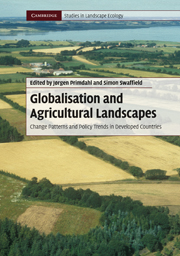Book contents
- Frontmatter
- Contents
- List of Contributors
- Preface
- 1 Globalisation and the sustainability of agricultural landscapes
- 2 Agricultural liberalisation, multifunctionality and the WTO: competing agendas for the future of farmed landscapes
- 3 Globalisation of agricultural landscapes: a land systems approach
- 4 Agricultural landscape changes through globalisation and biodiversity effects
- 5 Swiss agricultural policy reform: landscape changes in consequence of national agricultural policy and international competition pressure
- 6 Local landscape consequences of macro-scale policy reform: the New Zealand experiment
- 7 Rural landscape differentiation in the face of changing demands and policies: a typology of rural areas in Portugal
- 8 Globalisation and the local agricultural landscape: current change patterns and public policy interventions
- 9 From totalitarian to democratic landscapes: the transition in Estonia
- 10 Rural landscape change as a product of US federal policy
- 11 New approaches for urban–rural areas in Dutch spatial planning
- 12 Restoring agricultural landscapes in shrinking cities: re-inventing traditional concepts in Japanese planning
- 13 Globalisation and local agricultural landscapes: patterns of change, policy dilemmas and research questions
- Index
- References
3 - Globalisation of agricultural landscapes: a land systems approach
Published online by Cambridge University Press: 05 June 2012
- Frontmatter
- Contents
- List of Contributors
- Preface
- 1 Globalisation and the sustainability of agricultural landscapes
- 2 Agricultural liberalisation, multifunctionality and the WTO: competing agendas for the future of farmed landscapes
- 3 Globalisation of agricultural landscapes: a land systems approach
- 4 Agricultural landscape changes through globalisation and biodiversity effects
- 5 Swiss agricultural policy reform: landscape changes in consequence of national agricultural policy and international competition pressure
- 6 Local landscape consequences of macro-scale policy reform: the New Zealand experiment
- 7 Rural landscape differentiation in the face of changing demands and policies: a typology of rural areas in Portugal
- 8 Globalisation and the local agricultural landscape: current change patterns and public policy interventions
- 9 From totalitarian to democratic landscapes: the transition in Estonia
- 10 Rural landscape change as a product of US federal policy
- 11 New approaches for urban–rural areas in Dutch spatial planning
- 12 Restoring agricultural landscapes in shrinking cities: re-inventing traditional concepts in Japanese planning
- 13 Globalisation and local agricultural landscapes: patterns of change, policy dilemmas and research questions
- Index
- References
Summary
Introduction
As noted in the introduction, the aim of this book is to bring together two complementary analytical perspectives: landscape ecological research on change in agricultural landscape systems, and landscape planning and agri-environmental policy analysis. The objective is to provide a synthetic understanding of changing agricultural landscapes in the context of market conditions, technological developments, the sociocultural and environmental conditions for farming, and specific combinations of public policy frameworks.
Hence, the ambition is to create a conceptual and methodological framework that is capable of capturing the way in which a landscape is shaped and functions – partly as a result of decisions taken by local agents, and partly in response to conditions created on regional to global scales. External driving forces are acknowledged as increasingly affecting the local landscape, through the various shifts in the societal dynamics that are frequently labelled globalisation.
In other words, the dynamic of the agricultural landscape is seen through the lens of a coupled human–environmental system which transcends local to global scales. Significant progress has already been made in deepening the understanding of the dynamic human–environment interaction associated with changes in the land system over the last few decades. It has been stressed that many of the pressing environmental issues related to the footprints of human activity, for example the use of land, require an interdisciplinary perspective, combining different disciplines and scales (National Research Council, 1997; Liverman, 1999; Skole, 2004).
- Type
- Chapter
- Information
- Globalisation and Agricultural LandscapesChange Patterns and Policy trends in Developed Countries, pp. 31 - 56Publisher: Cambridge University PressPrint publication year: 2010
References
- 3
- Cited by



